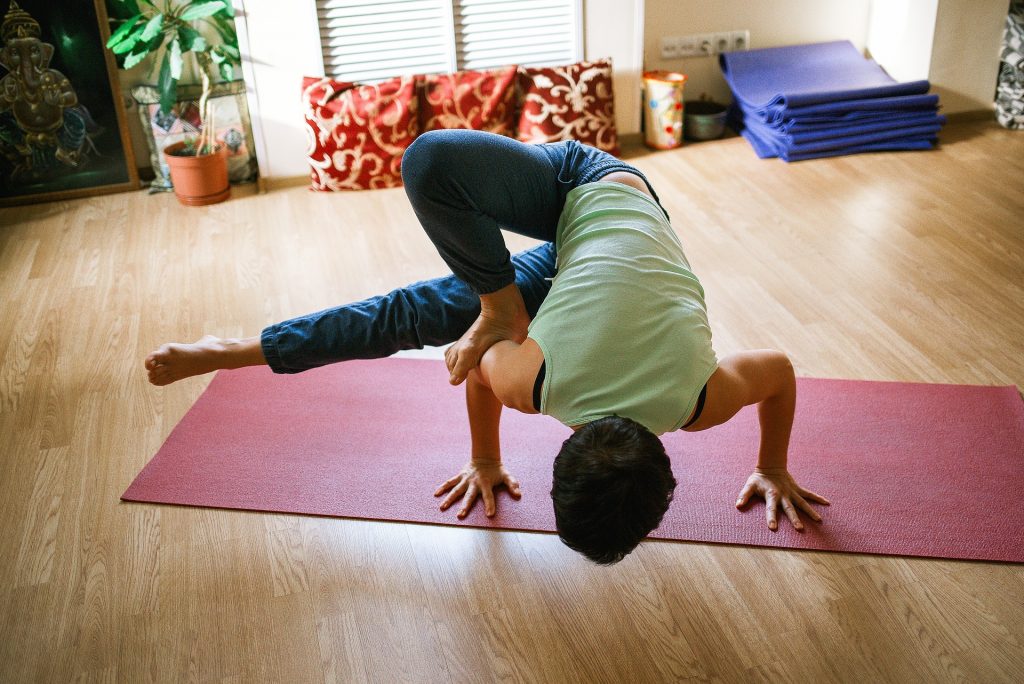Practicing yoga provides so many benefits and advantages that I won't go into long explanations, but let's just start with the essentials. I present to you
35 benefits of yoga
The benefits we have gathered are based on scientific research from India and the Western world and explain how yoga can both prevent some diseases and help us recover from them.
1. Yoga improves your flexibility
Improved flexibility is one of the first and most obvious benefits of yoga practice. During your first class, you probably won't be able to touch your toes, but if you're persistent, you'll notice a gradual loosening and eventually you'll be hitting some remarkable poses.
You will probably also notice that the aches and pains start to disappear. This is not accidental. Tight hips can strain the knee joint due to misalignment of the hip and shins. Tight lower legs can cause the lumbar spine to flatten, which can cause back pain. And muscle stiffness can cause poor posture.
2. Yoga builds muscle strength
Strong muscles protect us from conditions like arthritis and back pain and help prevent falls in older people. And when you build strength through yoga, you balance it with flexibility. That is, if you just go to the gym and lift weights, you may build strength at the expense of flexibility.
3. Yoga improves your posture
Poor posture can cause problems with the back, neck and other muscles and joints. After standing up all day, your body starts to feel tired and can compensate by straightening out the normal internal curves in your neck and lower back. This can cause pain and degenerative arthritis of the spine.
There are a number of exercises in yoga that help maintain proper posture and prevent various spine disorders.
4. Prevents cartilage and joint disorders
Every time you practice yoga, you take your joints through their full range of motion. This can help prevent degenerative arthritis or damage by "squeezing and absorbing" areas of cartilage that are not normally used. Articular cartilage is like a sponge - it receives fresh nutrients only when its fluid is pushed out and a new supply can be taken up. Without proper nourishment, neglected areas of cartilage can eventually wear away.
5. Yoga protects the spine
Spinal discs — the shock absorbers between the vertebrae that can herniate and compress nerves — crave movement. That's the only way they get their nutrients. If you have a well-balanced asana practice with plenty of back and forth movement, you'll be able to keep your discs flexible.

6. Improves bone health
Weight-bearing exercise strengthens bones and helps prevent osteoporosis. Many yoga poses require you to lift your own weight.
In an unpublished study conducted at the University of California, Los Angeles, yoga practice increased bone density in the vertebrae. Yoga's ability to lower levels of the stress hormone cortisol may help retain calcium in the bones.
7. Increases blood flow
Relaxation exercises in yoga can help your circulation, especially in your arms and legs. Practicing yoga also brings more oxygen to your cells, which function better as a result.
Inverted poses, such as headstand, handstand, and shoulderstand, encourage venous blood from the legs and pelvis to flow back to the heart, where it can be pumped to the lungs to be freshly oxygenated. This can help if you have swelling in your legs, heart or kidney problems.
In addition, yoga increases the levels of hemoglobin and red blood cells, which carry oxygen to the tissues.
8. Drains the lymph and increases immunity
When you contract and stretch muscles, move organs around, and move in and out of yoga poses, you increase the drainage of lymph (a viscous fluid rich in immune cells). This helps the lymphatic system fight infections, destroy cancer cells and flush out toxic waste products.
9. Increases heart rate
An increase in heart rate reduces the risk of heart attack and can relieve depression. When you do yoga vigorously or do Ashtanga classes, it can increase your heart rate.
But even yoga exercises that don't raise your heart rate can improve cardiovascular fitness. Studies have found that yoga practice increases endurance and can improve your maximal oxygen uptake during exercise—all reflections of improved aerobic fitness.
Another study found that individuals who were trained in pranayama alone could do more exercise with less oxygen.
10. Lowers blood pressure
If you have high blood pressure, you may benefit from a yoga practice.
One study found that participants over 40 who practiced yoga for five years had lower blood pressure and heart rate than those who did not.
High blood pressure is one of the main causes of heart problems such as heart attacks and stroke. Lowering blood pressure can help reduce the risk of these problems.
11. Regulates the adrenal glands
Yoga lowers cortisol levels. Normally, the adrenal glands secrete cortisol in response to an acute crisis, which temporarily boosts immune function. If cortisol levels remain high, even after the crisis, they can compromise the immune system. Temporary increases in cortisol help with long-term memory, but chronically high levels harm memory and can lead to permanent changes in the brain. Additionally, excessive cortisol is associated with major depression, osteoporosis, high blood pressure, and insulin resistance.
12. It makes you happier
One study found that consistent yoga practice lowered levels of depression and resulted in significant increases in serotonin levels and decreases in monoamine oxidase (an enzyme that breaks down neurotransmitters) and cortisol levels. At the University of Wisconsin, Dr. Richard Davidson found that the left prefrontal cortex showed increased activity in meditators. This finding has been linked to greater levels of happiness and better immune function.
13. Promotes a healthy lifestyle
Move more, eat less is the adage of many diets. Yoga can help on both fronts. Regular practice gets you moving and burning calories, and the spiritual and emotional dimensions of your practice can encourage you to tackle any eating and weight issues on a deeper level. Yoga can also inspire you to become more aware and sensitive about food.

14. Lowers blood sugar
Yoga lowers blood sugar and LDL ("bad") cholesterol and raises HDL ("good") cholesterol. In people with diabetes, yoga has been found to lower blood sugar in several ways: by lowering adrenaline levels, promoting weight loss, and improving sensitivity to the effects of insulin. Lower your blood sugar levels and reduce your risk of diabetic complications such as heart attack, kidney failure and blindness.
15. It helps you focus
An important component of yoga is focusing on the present. Studies have found that regular yoga practice improves coordination, reaction time, memory and even IQ scores. People who practice Transcendental Meditation demonstrate the ability to solve problems and acquire and recall information better, possibly because they are less distracted in their thoughts.
16. Relax
Yoga encourages you to relax, slow your breath and focus on the present, shifting the balance from the sympathetic nervous system to the parasympathetic nervous system. The latter is soothing and restorative – it lowers breathing and heart rate, lowers blood pressure and increases blood flow to the intestines and reproductive organs.
17. Improves balance
Regular yoga practice increases proprioception (the ability to sense what your body is doing and where it is) and improves balance. People with poor posture or dysfunctional movement patterns tend to have poor proprioception, which is linked to knee problems and back pain.
Better balance can mean fewer falls. For seniors, this means more independence.
18. Supports the nervous system
Some advanced yogis can control their bodies in extraordinary ways, many of which are mediated by the nervous system. Scientists observed yogis who could induce abnormal heart rhythms, generate specific brain wave patterns and, using the meditation technique, raise the temperature of their hands.
19. Relieves tension in the limbs
Certain unconscious habits we perform with our limbs can lead to chronic tension, muscle fatigue and soreness in the wrists, arms, shoulders, neck and face, which can increase stress and worsen your mood.
As you practice yoga, you begin to notice where you hold tension: it may be in the eyes or the muscles of the face and neck. If you just tune in, you may be able to release some tension. For larger muscles like the quadriceps, trapezius and glutes, it can take years of practice to learn how to relax them.
20. It helps you sleep more deeply
Poor sleep quality has been linked to obesity, high blood pressure and depression, among other disorders.
Studies show that incorporating yoga into your routine can help promote better sleep.
In a 2005 study, 69 elderly patients were divided into two groups, one who practiced yoga and the other who received regular herbal treatment.
The yoga group fell asleep faster, longer and felt more rested in the morning than the other group.
Another study looked at the effects of yoga on sleep in patients with lymphoma. The results show that yoga reduces sleep disturbances, improves sleep quality and duration, and reduces the need for sleep medication.
It is important to note that yoga has significant effects on anxiety, depression, chronic pain and stress – all of which often contribute to sleep problems.
21. Increases the functionality of your immune system
Asana and pranayama probably improve immune function, but so far meditation has the strongest scientific support in this area. It appears to have a beneficial effect on the functioning of the immune system by boosting it when needed (eg raising antibody levels in response to a vaccine) and lowering it when needed.
22. Makes the lungs breathe
Yogis tend to take fewer, higher-volume breaths, which is both calming and more effective.

A 1998 study published in The Lancet examined a yogic technique known as like "full breathing" of people with lung problems due to heart failure. After one month, their average breathing rate dropped from 13.4 breaths per minute to 7.6. Meanwhile, their exercise capacity increases significantly, as does the oxygen saturation in their blood.
Yoga also encourages nasal breathing, which filters the air, warms it (cold, dry air is more likely to trigger an asthma attack in sensitive people), and humidifies it, removing dust, dirt, and other things you'd rather not get into. lungs.
23. Prevents IBS and other digestive problems
Ulcers, irritable bowel syndrome, constipation can all be exacerbated by stress. Yoga, like any exercise, can relieve constipation and theoretically reduce the risk of colon cancer because moving the body facilitates faster transport of food and waste products through the intestines. And although this hasn't been scientifically researched, yogis believe that twisting poses can be beneficial in getting waste moving through the system.
24. Gives peace of mind
Yoga quells the fluctuations of the mind, various practitioners believe. In other words, it slows down the mental loops of helplessness, regret, anger, and fear that can cause stress. And because stress is implicated in so many health problems—from migraines and insomnia to lupus, eczema, high blood pressure, and heart attacks—if you learn to quiet your mind, you're likely to live a longer, healthier life.
25. It boosts your self-esteem
Many of us suffer from chronic low self-esteem. If you deal with it with a negative attitude—taking drugs, overeating, working too hard, sleeping too little—you may pay the price in ill health, whether physical, mental or spiritual.
Practicing yoga, you will realize that as yoga philosophy teaches, you are a manifestation of the Divine. If you exercise regularly with the intention of improving, and not just as a substitute for an aerobics class, you can get to know yourself on another level. You will experience feelings of gratitude, empathy and forgiveness, as well as a sense of being part of something bigger.
26. Relieves pain
Yoga can ease your pain. According to several studies, asana, meditation, or a combination of the two reduce pain in people with arthritis, back pain, fibromyalgia, carpal tunnel syndrome, and other chronic conditions.
27. Gives inner strength
Yoga can help you make changes in your life. In fact, this is perhaps her greatest strength. Tapas, the Sanskrit word for "heat," is the discipline that fuels yoga and that builds regular practice. The tapas you develop can extend to the rest of your life to overcome inertia and change dysfunctional habits. You may find that without making much of an effort to change things, you begin to eat better, exercise more, or quit smoking after years of unsuccessful attempts.
28. Helps you stay away from drugs
If your medicine cabinet looks like a drugstore, it might be time to try yoga. Studies of people with asthma, high blood pressure, type II diabetes (formerly adult-onset diabetes) and obsessive-compulsive disorder show that yoga practice helps them reduce their medication dosage and sometimes stop them altogether. And what are the benefits of taking fewer medications? You'll spend less money and you're less likely to suffer side effects and risk dangerous drug interactions.

29. Builds awareness for transformation
Yoga and meditation build awareness. And the more aware you are, the easier it is to let go of destructive emotions like anger. Studies show that chronic anger and hostility are as strongly linked to heart attacks as smoking, diabetes and high cholesterol. Yoga appears to reduce anger, by increasing feelings of compassion and connectedness, and by calming the nervous system and mind. It also increases your ability to step back from the drama of your own life, to remain steadfast in the face of bad news or troubling events.
30. Advantages in relationships with others
Cultivating the emotional support of friends, family, and community has been shown repeatedly to improve health and healing. Regular yoga practice helps develop friendliness, compassion and greater equanimity. Along with yogic philosophy's emphasis on avoiding harm to others, telling the truth and accepting only what you need can improve many of your relationships.
31. Keeps allergies and viruses at bay
Purifying practices are another element of yoga. These include everything from fast breathing exercises to working on an internal bowel cleanse. Jala neti, which involves gently flushing the nasal passages with salt water, removes pollen and viruses from the nose, keeps mucus from building up and helps drain the sinuses.
32. It helps to serve others
Karma yoga (service to others) is an integral part of yogic philosophy. And while you may be reluctant to serve others, your health may improve if you do.
Serving others can give the meaning of life you and your problems may not seem so daunting when you see what other people are dealing with.
33. Encourages self-care
In much of conventional medicine, most patients are passive recipients of care. What matters in yoga is what you do for yourself. Yoga gives you the tools to to help you change and you may start to feel better the first time you try to practice.
You may also notice that the more you commit to practicing yoga, the more you will benefit. Practicing does three things: You get involved in your own care, you find that your involvement gives you the power to make a change, and seeing that you can make a change gives you hope. And hope itself can be healing.
34. Supports your connective tissue
As you read through all the ways yoga improves your health, you probably noticed a lot of overlap. This is because they are intensely intertwined. Change your posture and you will change the way you breathe. Change your breathing and you will change your nervous system. This is one of the greatest lessons of yoga: Everything is connected. This holistic system simultaneously engages in many mechanisms that have additive and even multiplicative effects. This synergy is perhaps the most important way of all that yoga heals.
35. Uses the placebo effect to affect change
Only believing that you will improve can make you better. Unfortunately, many conventional scientists believe that if something works by eliciting a placebo effect, it doesn't count. But most patients just want to get better, so if chanting a mantra—as you would at the beginning or end of a yoga class or during meditation—facilitates healing, even if it's just a placebo effect, why not do it.
These are 35 Benefits of Yoga, and the easiest and safest way to enjoy yoga anywhere and anytime is with the online yoga practices of Milena Goleva – creator of the greatest online yoga studio in which people from all corners of the globe practice.






Comments are closed.